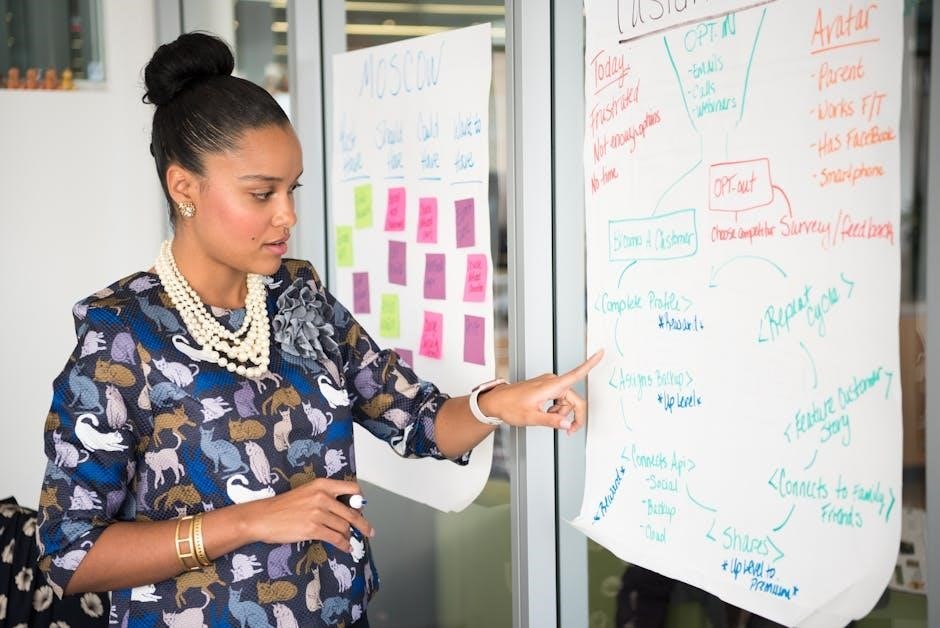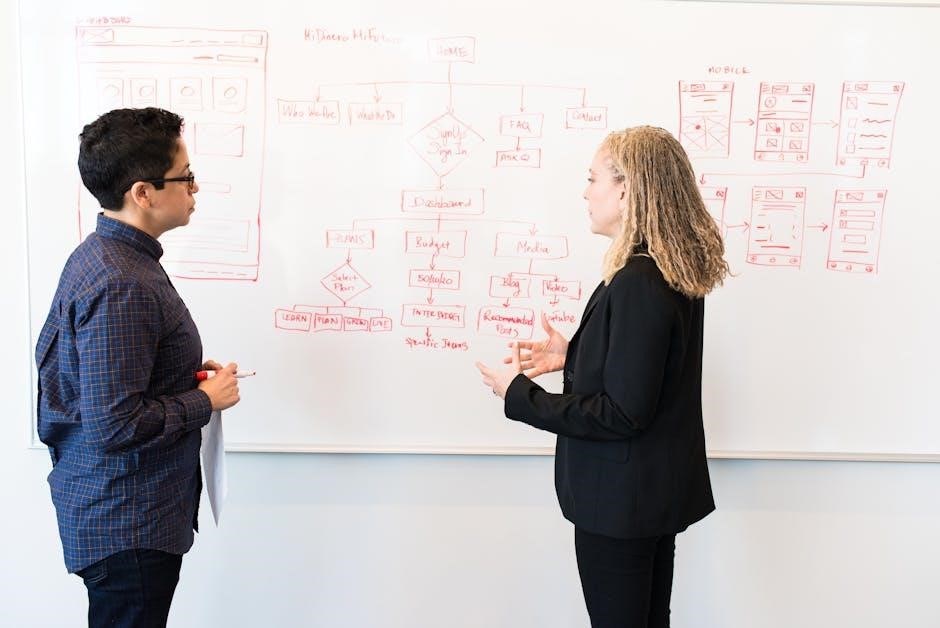
absolute beginner’s guide to project management
Project management is the process of organizing and overseeing tasks to achieve specific goals efficiently. It helps teams deliver results on time and within budget.
1.1 What is Project Management?
Project management is the systematic process of planning, organizing, and overseeing the execution of specific goals or objectives. It involves coordinating resources, tasks, and stakeholders to deliver projects efficiently. The primary aim is to ensure projects are completed on time, within budget, and to the required quality standards. Project management encompasses defining scope, setting timelines, allocating resources, and mitigating risks. It ensures clarity, accountability, and alignment with organizational goals, making it a cornerstone of successful business operations and team collaboration.
1.2 Why is Project Management Important?
Project management is essential for ensuring projects are completed efficiently, meeting objectives, and delivering value. It enhances collaboration, reduces risks, and improves resource utilization. By providing clear direction, it helps teams stay aligned with organizational goals. Effective project management fosters accountability, ensuring tasks are completed on time and within budget. It also enables better communication, minimizing misunderstandings and conflicts. Ultimately, it ensures that projects deliver the expected outcomes, satisfying stakeholders and contributing to business success. Proper project management practices are vital for achieving consistent and sustainable results in any industry or endeavor.

Defining Project Management
Project management is the art and science of planning and executing projects. It involves setting goals, organizing resources, and ensuring timely completion while managing scope, time, and quality effectively.
2.1 The Basics of Project Management
Project management involves defining clear goals, setting timelines, and allocating resources to ensure tasks are completed efficiently. It encompasses planning, organizing, and overseeing activities to achieve desired outcomes. The process includes initiating, planning, executing, monitoring, and closing phases. Effective project management requires clear communication, coordination, and control of all elements. It ensures that deliverables meet expectations while managing risks and changes. Understanding these fundamentals helps teams deliver projects successfully, fostering productivity and satisfaction for all stakeholders involved.
2.2 Key Concepts in Project Management
Key concepts in project management include understanding stakeholders, deliverables, milestones, and scope. Stakeholders are individuals or groups affected by the project, while deliverables are the tangible outcomes. Milestones mark significant progress points, and scope defines the project’s boundaries. Resource allocation, timelines, and budgets are also crucial. These concepts help ensure clarity, alignment, and successful execution. They form the foundation for planning, tracking, and delivering projects effectively, making them essential for any project manager to master.

The Role of a Project Manager
A project manager oversees the planning, execution, and closing of projects, ensuring they are completed on time, within budget, and meet quality standards. They guide teams, communicate with stakeholders, and manage risks to achieve successful outcomes.
3.1 Responsibilities of a Project Manager
A project manager is responsible for planning, executing, and completing projects successfully. They define goals, assign tasks, and manage timelines and budgets. They also identify and mitigate risks, ensuring quality standards are met. Communicating with stakeholders, resolving conflicts, and motivating the team are key duties. They monitor progress, make adjustments as needed, and ensure deliverables align with expectations. ultimately, the project manager ensures the project is completed on time, within budget, and to the satisfaction of all stakeholders.
3.2 Skills Required for a Project Manager
A successful project manager must possess a combination of hard and soft skills. Communication is critical to ensure clarity and alignment among team members. Leadership skills are essential to motivate and guide the team toward shared goals. Time management and organization are vital to meet deadlines and juggle multiple tasks. Risk management skills help anticipate and mitigate potential issues. Stakeholder engagement ensures that expectations are managed effectively. Additionally, emotional intelligence, problem-solving, and adaptability are key traits for navigating challenges. Proficiency in project management tools and methodologies further enhances efficiency and effectiveness in delivering successful outcomes.

The Project Management Process
The project management process is a structured approach to planning, executing, and completing projects. It involves distinct phases and activities to ensure efficiency and goal achievement.
4.1 Phases of Project Management
Project management is divided into distinct phases that guide the journey from concept to completion. These phases provide a structured approach to ensure tasks are executed systematically. The primary phases include initiation, planning, execution, monitoring and control, and closing. Each phase serves a specific purpose, such as defining goals, allocating resources, implementing plans, tracking progress, and finalizing deliverables. Understanding these phases helps teams manage workflows effectively, ensuring projects are completed on time and within scope. This framework is essential for maintaining clarity and direction throughout the project lifecycle.
4.2 Initiation Phase
The initiation phase is the starting point of a project where goals, objectives, and scope are defined. It involves assessing feasibility, identifying stakeholders, and outlining high-level deliverables. Key activities include defining project goals, conducting a feasibility study, and preparing a project charter or proposal. This phase ensures everyone involved understands the project’s purpose and aligns expectations. It sets the foundation for success by establishing clear objectives and securing stakeholder approval. The initiation phase is crucial for ensuring the project aligns with organizational goals and obtains the necessary resources and approvals to move forward.
4.3 Planning Phase
The planning phase is a critical step where the project roadmap is defined. It involves creating a detailed plan outlining project objectives, scope, timelines, and resources. Key activities include breaking down work into manageable tasks, assigning roles, and establishing milestones. Budgeting, risk assessment, and communication plans are also finalized. This phase ensures everyone understands their responsibilities and aligns with the project goals. Effective planning sets the foundation for smooth execution and helps mitigate potential challenges early on. It’s about organizing ideas and resources to achieve the desired outcomes efficiently.
4.4 Execution Phase
The execution phase is where the project plan transitions into action. Tasks are assigned, and team members begin working on deliverables. The project manager oversees progress, ensuring activities align with the plan. This phase involves implementing workflows, managing resources, and addressing any issues that arise. Regular updates and status reports are essential to keep stakeholders informed. The project manager must also manage risks and make adjustments as needed to stay on track. Effective communication and collaboration are critical during this phase to ensure successful delivery of the project’s objectives.
4.5 Monitoring and Control Phase
The Monitoring and Control Phase ensures the project stays on track by continuously tracking progress, identifying deviations, and taking corrective actions. It involves regular status updates, performance reviews, and comparing actual outcomes with planned goals. This phase uses tools like Gantt charts, dashboards, and Earned Value Management to monitor timelines, budgets, and quality. Issues like scope creep or unexpected risks are addressed promptly to prevent derailment. Effective communication and adaptability are key, ensuring the project aligns with its objectives and stakeholder expectations. This phase is crucial for maintaining control and delivering the project successfully.
4.6 Closing Phase
The closing phase marks the official completion of a project. It involves delivering the final product, obtaining formal acceptance from stakeholders, and documenting lessons learned. This phase ensures all tasks are finalized, contracts are closed, and resources are reallocated. A post-project review is conducted to evaluate successes, identify areas for improvement, and archive knowledge for future initiatives. Proper closure ensures accountability, celebrates achievements, and prepares the team for upcoming projects.

Essential Skills for Project Managers
Effective project managers possess strong communication, leadership, and time management abilities. They must also excel in risk management and stakeholder engagement to ensure project success.
5.1 Communication Skills
Effective communication is the cornerstone of successful project management. It involves clearly conveying ideas, listening actively, and ensuring all stakeholders understand their roles and expectations. Verbal and written communication are equally important, as they help prevent misunderstandings and ensure alignment. A project manager must adapt their communication style to diverse team members and stakeholders, fostering collaboration and trust. Regular updates, transparent feedback, and active engagement are essential to maintain momentum and address issues promptly. Strong communication skills ensure that everyone is on the same page, ultimately driving the project toward its goals efficiently.
5.2 Leadership Skills
Leadership skills are essential for guiding teams toward project goals. A project manager must inspire, motivate, and empower team members to perform at their best. Strong leaders foster collaboration, make informed decisions, and maintain a clear vision. They navigate conflicts, adapt to challenges, and ensure alignment with project objectives. Effective leaders build trust, encourage open communication, and create an environment where team members feel valued. Developing leadership skills helps project managers drive success, even in uncertain or high-pressure situations. Cultivating these abilities ensures teams remain focused, productive, and committed to achieving shared outcomes.
5.3 Time Management Skills
Time management is crucial for project managers to ensure tasks are completed efficiently. It involves prioritizing activities, allocating time wisely, and meeting deadlines without compromising quality. Effective time management helps in minimizing delays, reducing stress, and enhancing productivity. Techniques like creating detailed schedules, using calendars, and breaking tasks into manageable chunks are essential. Additionally, understanding how to handle multitasking and avoid procrastination is vital. Strong time management fosters a sense of control and ensures that resources are utilized optimally, leading to successful project outcomes and stakeholder satisfaction.
5.4 Risk Management Skills
Risk management skills enable project managers to identify, assess, and mitigate potential threats that could impact the project. This involves creating a risk register, evaluating probabilities, and developing contingency plans. Effective risk management ensures proactive responses to challenges, minimizing delays and budget overruns. It also includes monitoring risks throughout the project lifecycle and communicating strategies to stakeholders. Strong analytical and problem-solving abilities are essential for anticipating and addressing risks effectively. By managing risks, project managers can safeguard project goals and deliver successful outcomes.
5.5 Stakeholder Engagement Skills
Stakeholder engagement skills are crucial for project managers to ensure all parties are aligned and informed. Effective communication helps build trust and addresses concerns early, preventing conflicts. Active listening and empathy are key to understanding diverse perspectives. Regular updates and clear reporting keep stakeholders engaged, fostering collaboration. Strong negotiation skills also help balance competing demands. Managing expectations and ensuring stakeholders feel valued enhances commitment and support for the project. These skills contribute significantly to the project’s success by maintaining a positive and productive relationship with all involved.

Project Management Tools and Techniques
Project management tools and techniques enhance efficiency by organizing tasks, tracking progress, and streamlining workflows. They include methodologies, software, and practices to ensure successful project execution.
6.1 Overview of Project Management Methodologies
Project management methodologies are structured approaches that guide how projects are planned, executed, and delivered. They provide frameworks for organizing tasks, managing timelines, and ensuring goals are met. These methodologies help teams stay aligned, improve efficiency, and maintain consistency. By adopting a methodology, organizations can standardize processes, reduce risks, and enhance collaboration. Common methodologies include Agile, Waterfall, Scrum, Kanban, and Hybrid models, each suited for different project types and sizes. Understanding these methodologies is essential for selecting the right approach to match project requirements and ensure successful outcomes.
6.2 Agile, Scrum, and Waterfall: A Comparison
Agile, Scrum, and Waterfall are popular project management methodologies; Agile emphasizes flexibility, collaboration, and iterative progress, making it ideal for dynamic environments. Scrum is a framework within Agile, focusing on short sprints and regular feedback. Waterfall follows a linear, sequential approach, with each phase completed before the next begins. Agile and Scrum are best for projects with changing requirements, while Waterfall suits well-defined, fixed projects. Understanding these methodologies helps teams choose the right approach for their needs, ensuring efficient project delivery.
6.3 Tools for Project Management (e.g., Trello, Asana, MS Project)
Project management tools like Trello, Asana, and Microsoft Project streamline task organization, collaboration, and progress tracking. Trello uses Kanban boards for visual task management, while Asana excels at assigning and tracking tasks. Microsoft Project offers advanced scheduling and resource management features. These tools help teams stay aligned, set deadlines, and monitor progress efficiently. They also enable real-time collaboration, reducing communication gaps. Beginners can start with user-friendly options like Trello or Asana, while larger teams might benefit from MS Project. Other tools like Jira and Basecamp also provide robust solutions tailored to specific needs, ensuring productivity and accountability across projects.

Common Challenges in Project Management
Project management often involves overcoming challenges like resource allocation, communication gaps, and unexpected changes. These issues can impact timelines, budgets, and team morale if not addressed effectively.
7.1 Dealing with Scope Creep
Scope creep occurs when a project’s objectives or deliverables expand beyond the original plan, often causing delays or budget overruns. It can result from unclear requirements, stakeholder changes, or poor communication. To manage scope creep, define clear project boundaries and use a formal change management process. Regularly review and prioritize changes with stakeholders, ensuring alignment with the project’s goals. Effective communication and strong documentation can help mitigate its impact. Addressing scope creep early ensures the project stays on track and meets its intended outcomes without unnecessary complexity or cost.
7.2 Managing Project Delays
Project delays are common challenges that can arise due to unforeseen issues, poor planning, or resource shortages. To manage delays, identify the root cause and assess its impact on the timeline. Prioritize tasks, adjust schedules, and allocate additional resources if needed. Communicate proactively with stakeholders to set realistic expectations and maintain trust. Implement contingency plans to mitigate further disruptions. Finally, document lessons learned to improve future project planning and execution. Effective communication and adaptability are key to minimizing delays and ensuring project success.
7.3 Handling Budget Constraints
Handling budget constraints requires careful planning and prioritization. Start by identifying essential project components and allocating resources effectively. Use cost-saving techniques like negotiating contracts or leveraging free tools. Regularly monitor expenses to ensure alignment with the budget. Address financial risks early to prevent overspending. Consider reallocating funds from less critical tasks to prioritize high-impact activities. Effective communication with stakeholders about budget limitations helps manage expectations. By maintaining financial discipline and flexibility, project managers can deliver successful outcomes even with limited resources.
7.4 Managing Team Conflicts
Managing team conflicts is crucial for maintaining harmony and productivity within a project team. Conflicts often arise from differing opinions, communication gaps, or competing priorities. Addressing conflicts promptly helps prevent escalation. Techniques like active listening, open communication, and fostering respect can resolve issues effectively. Encouraging a collaborative environment where team members feel heard and valued minimizes friction. Project managers should mediate fairly, focusing on solutions that align with project goals. By addressing conflicts constructively, teams can strengthen their dynamics and improve overall performance. Effective conflict resolution is a key skill for successful project outcomes.

Best Practices for Successful Project Management
Adopting best practices ensures projects are well-executed. Start with clear goals, allocate resources wisely, and monitor progress regularly. Foster collaboration and embrace continuous learning for sustainable success.
8.1 Setting Clear Goals and Objectives
Setting clear goals and objectives is essential for effective project management. Goals define the project’s purpose, while objectives outline measurable steps to achieve it. Clear goals ensure everyone understands the project’s direction, fostering alignment and focus. Objectives should be specific, measurable, achievable, relevant, and time-bound (SMART). Well-defined goals help prioritize tasks, allocate resources efficiently, and track progress. They also guide decision-making and reduce ambiguity. By establishing clear expectations, teams stay motivated and work toward a common purpose, increasing the likelihood of project success.
8.2 Effective Resource Allocation

Effective resource allocation ensures that the right materials, people, and budget are assigned to the right tasks at the right time. It maximizes efficiency, ensures deadlines are met, and keeps costs under control. Proper allocation prevents over- or under-utilization of resources, which can lead to delays or overspending. To achieve this, prioritize tasks based on project goals, use inventory systems to track availability, and employ project management tools like Gantt charts or resource management software. Regularly review and adjust allocations to adapt to changing project needs and ensure optimal productivity.
8.3 Regular Monitoring and Reporting
Regular monitoring and reporting are essential for maintaining project transparency and ensuring progress aligns with goals. By consistently tracking tasks and performance metrics, teams can identify potential issues early and make timely adjustments. Reporting helps stakeholders stay informed about project status, risks, and achievements. Using tools like dashboards and status updates, project managers can communicate progress effectively. This practice also ensures accountability and helps maintain momentum. Regular check-ins and updates foster collaboration and allow for proactive problem-solving, ensuring the project stays on track and meets its objectives successfully.
8.4 Continuous Improvement and Learning
Continuous improvement and learning are essential for long-term project management success. By analyzing project outcomes and incorporating feedback, teams can refine processes and enhance future results. Learning from successes and failures fosters a culture of growth, allowing team members to develop new skills and adapt to changing demands. Regular retrospectives and debriefs help identify areas for improvement, ensuring that best practices are adopted and mistakes are not repeated. This iterative approach not only boosts efficiency but also prepares teams to handle complex challenges with greater confidence and innovation.

Real-Life Examples of Project Management
Real-life examples of project management demonstrate how methodologies and strategies are applied in diverse industries, showcasing successes and lessons learned to illustrate practical applications.
9.1 Case Study: Successful Project Execution
A tech startup developed a user-friendly fitness app, setting clear objectives and timelines. Using Agile methodologies, they ensured adaptability and stakeholder engagement. Regular sprints and feedback loops facilitated smooth execution. Effective teamwork and communication led to meeting the deadline and budget.
The app’s launch was successful, attracting a large user base and positive reviews. This case highlights the importance of clear planning, adaptability, and strong leadership in achieving project goals.
9.2 Lessons Learned from Failed Projects
Analyzing failed projects reveals valuable insights into common pitfalls, such as poor planning, unrealistic timelines, or inadequate resource allocation. Many failures stem from insufficient communication or misaligned stakeholder expectations. Overlooking risk management and failing to adapt to changes are also frequent contributors. These lessons emphasize the importance of thorough preparation, clear communication, and flexibility. By understanding what went wrong, project managers can develop strategies to avoid similar mistakes, fostering continuous improvement and enhancing future project success.
Project management is a vital skill for achieving goals efficiently. By mastering its principles, beginners can effectively plan, execute, and deliver successful outcomes, fostering continuous learning and growth.
10.1 Final Thoughts on Project Management
Project management is a vital skill that empowers individuals and teams to achieve goals efficiently. It combines organization, leadership, and adaptability to deliver successful outcomes. As you embark on your journey, remember that effective project management is about balance—balancing timelines, budgets, and stakeholder expectations. Developing strong communication and problem-solving skills will serve you well. Always be open to learning and improving, as every project presents new challenges and opportunities. With dedication and practice, you’ll master the art of guiding projects from concept to completion. Stay curious, stay organized, and you’ll excel in this dynamic field;
10.2 Encouragement for Aspiring Project Managers
Embarking on a project management journey can be both exciting and intimidating, but it’s a rewarding path that offers growth and fulfillment. As an aspiring project manager, remember that every skill can be learned and refined over time. Start small, embrace challenges, and learn from every experience. Building strong relationships, staying adaptable, and maintaining a proactive mindset will serve you well. The ability to lead teams and deliver impactful results is within your reach. Keep striving to improve, and you’ll find project management to be a deeply satisfying career.